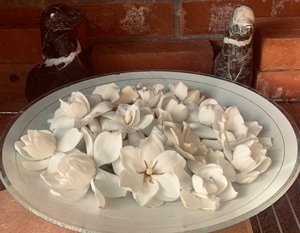Gardenias are evergreen trees and many species exude a solid and beautiful scent. There are more than 140 varieties of Gardenia. The most common house plant type is the Gardenia Jasminoides. It requires humidity and bright light but not direct sunlight to thrive. It prefers well-drained, acidic soil. The delicate petals of the flower can turn brown when water touches them for a longer time. Small tips that I resort to from experience with my large gardenia trees, they are taller than 2 meters already and more than 25 years old:
- I spread a layer of gravel on the ground all around them to prevent the cats from doing their business under them and to preserve the humidity of their spot.
- I add iron to the water I pour into the ground twice a year. And once, if needed, I add potassium dissolved in a large bucket of water. This helps keep their soil balanced and enriched for their needs.
- Light pruning of your gardenias should be done in February or after the flower shed. Not while it's blooming!
- When you avoid watering them for 48 hours, they will bloom beautifully. This is a survival mechanism that I observed many plants and flowers adopt.
- Pests and diseases that might affect your gardenia plant can most be treated in ecological and organic ways. Please avoid the overuse of chemicals to get rid of every little bug you see! Sometimes, strong water spraying with a hose can do the trick 😁
Beyond the beauty of the flowers that can be tiny or larger and the heavenly emanated scent, gardenias also provide oil that yields multiple benefits. It is not named essential oil because it is not made through distillation. It is the lengthy process of extraction from the flower, called enfleurage. Below is a list of benefits of gardenia oil:
- it is antibacterial and can be used to treat sepsis for example
- it is loaded with antioxidants, which help reduce scarring and hyper-pigmentation
- it can help protect your skin from the sun and heal wounds
- it has anti-inflammatory properties and can ease arthritis pains
- it is believed to have aphrodisiac characteristics and is used in multiple products such as soaps, candles, drops for inhalers and potpourri, and others
The oil can be used in perfumes, for a facial steam treatment, a massage, a bath, or a compress to relieve aching joints.
Be careful to refrain from ingesting gardenia oil. If you want to use it on your skin, dilute it in a carrier oil. And always consult your doctor who knows your medical history before any use.
And enjoy your fragrant bouquet of aromas!

